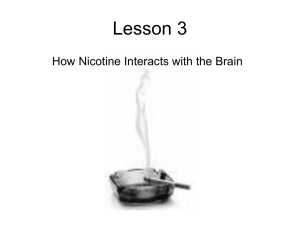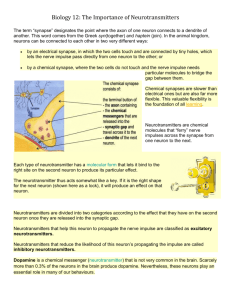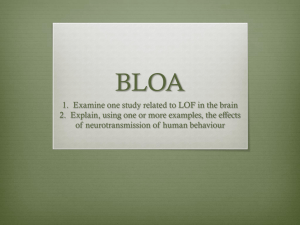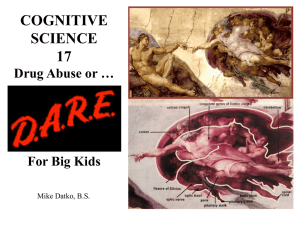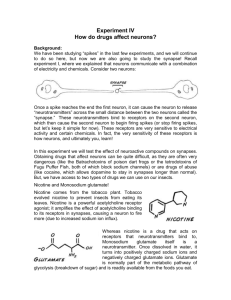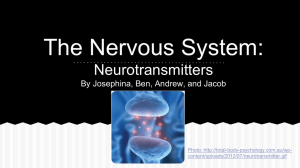MS Word - VCU Secrets of the Sequence
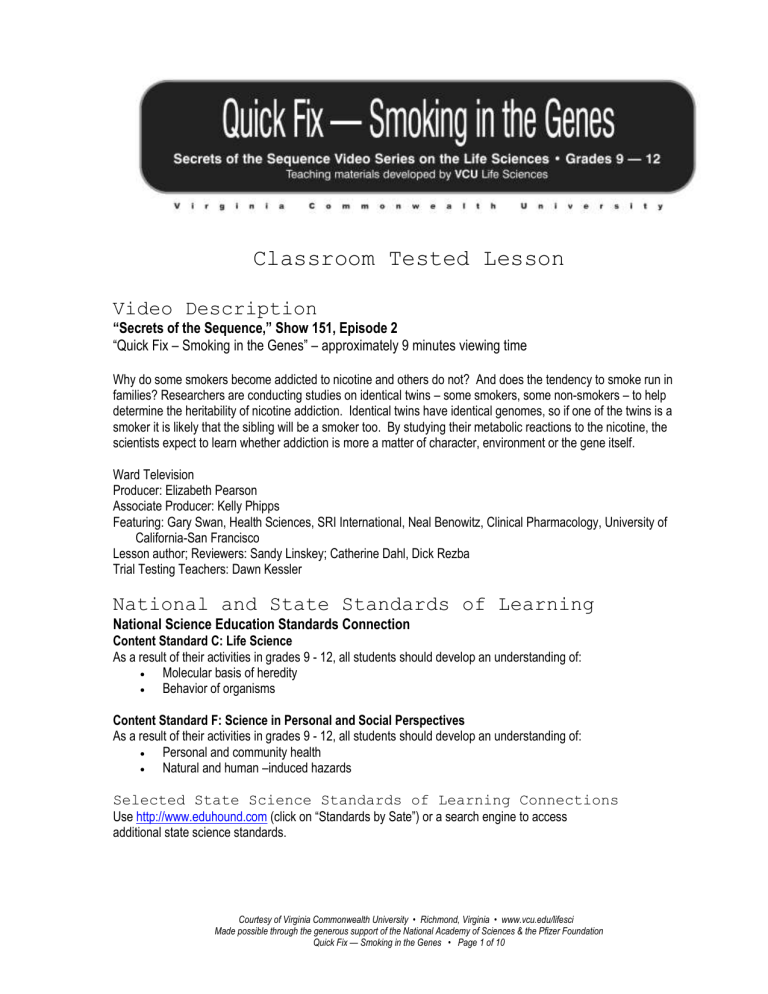
Classroom Tested Lesson
Video Description
“Secrets of the Sequence,” Show 151, Episode 2
“Quick Fix – Smoking in the Genes” – approximately 9 minutes viewing time
Why do some smokers become addicted to nicotine and others do not? And does the tendency to smoke run in families? Researchers are conducting studies on identical twins – some smokers, some non-smokers – to help determine the heritability of nicotine addiction. Identical twins have identical genomes, so if one of the twins is a smoker it is likely that the sibling will be a smoker too. By studying their metabolic reactions to the nicotine, the scientists expect to learn whether addiction is more a matter of character, environment or the gene itself.
Ward Television
Producer: Elizabeth Pearson
Associate Producer: Kelly Phipps
Featuring: Gary Swan, Health Sciences, SRI International, Neal Benowitz, Clinical Pharmacology, University of
California-San Francisco
Lesson author; Reviewers: Sandy Linskey; Catherine Dahl, Dick Rezba
Trial Testing Teachers: Dawn Kessler
National and State Standards of Learning
National Science Education Standards Connection
Content Standard C: Life Science
As a result of their activities in grades 9 - 12, all students should develop an understanding of:
Molecular basis of heredity
Behavior of organisms
Content Standard F: Science in Personal and Social Perspectives
As a result of their activities in grades 9 - 12, all students should develop an understanding of:
Personal and community health
Natural and human –induced hazards
Selected State Science Standards of Learning Connections
Use http://www.eduhound.com
(click on “Standards by Sate”) or a search engine to access additional state science standards.
Courtesy of Virginia Commonwealth University • Richmond, Virginia • www.vcu.edu/lifesci
Made possible through the generous support of the National Academy of Sciences & the Pfizer Foundation
Quick Fix — Smoking in the Genes • Page 1 of 10
California
9. As a result of the coordinated structures and functions of organ systems, the internal environment of the human body remains relatively stable (homeostatic) despite changes in the outside environment. As a basis for understanding this concept: b. Students know how the nervous system mediates communication between different parts of the body and the body's interactions with the environment. d. Students know the functions of the nervous system and the role of neurons in transmitting electrochemical impulses. e. Students know the roles of sensory neurons, interneurons, and motor neurons in sensation, thought, and response.
Indiana
Molecules and Cells
B.1.3. Know and describe that within the cell are specialized parts for the transport of materials, energy capture and release, protein building, waste disposal, information feedback, and movement. In addition to these basic cellular functions common to all cells, understand that most cells in multicellular organisms perform some special functions that others do not.
Developmental and Organismal Biology
B.1.14 Recognize and explain that communication and/or interaction are required between cells to coordinate their diverse activities.
B1.17 Understand that and describe how the maintenance of a relatively stable internal environment is required for the continuation of life and explain how stability is challenged by changing physical, chemical, and environmental conditions, as well as the presence of disease agents.
Genetics
B1.29 Understand that and explain how the actions of genes, patterns of inheritance, and the reproduction of cells and organisms account for the continuity of life, and give examples of how inherited characteristics can be observed at molecular and whole-organism levels-in structure, chemistry, or behavior.
Overview
Despite the warnings everywhere that smoking is harmful and potentially deadly, thousands of teenagers begin smoking each day, while thousands of smokers die daily from otherwise preventable deaths. Although the majority of smokers admit that their initial sensations were unpleasant due to coughing, dizziness, or nausea, they continue to smoke for a variety of reasons. Determining why at least 30% of these beginning smokers continue on to become addicted with little chance of quitting is more complex. Researchers are attempting to separate the environmental and the genetic factors that lead to these behaviors in order to better understand how to combat the addiction.
The primary methodology used is twin studies in order to separate “nature from nurture”. One study cited uses WWII era twins when smoking was considered “acceptable”, while the other uses young adult twins. Metabolic rates for nicotine and their relationship to addiction are being studied. The faster nicotine is metabolized, the faster a chemical associated with pleasure (dopamine) is disbursed in the brain and the more likely the individual is to become addicted.
If an individual is deficient in dopamine receptors, that individual needs to smoke more to acquire a pleasurable sensation – leading to a higher likelihood of addiction. Researchers are hoping to identify genetic markers to increase their ability to match specific anti-smoking drugs to an individual’s needs.
Courtesy of Virginia Commonwealth University • Richmond, Virginia • www.vcu.edu/lifesci
Made possible through the generous support of the National Academy of Sciences & the Pfizer Foundation
Quick Fix — Smoking in the Genes • Page 2 of 10
Testing: A sample related multiple choice item from State Standardized Exams
One similarity between cell receptors and antibodies is that both a) are produced by nerve cells b) are highly specific in their actions * c) slow the rates of chemical reactions d) are involved in digestion
Source: New York, Living Environment Regents Examination Part A, #24
Video Preparation
Preview the video and make note of the locations at which you will later pause the video for discussion.
Before Viewing
Ask students the following questions:
1.
What is the leading cause of preventable death?
Smoking. The two associated diseases are lung cancer and coronary heart disease.
2.
How many deaths a year in the United States are caused from smoking?
430,000 per year.
3.
What percentage of teens do you think try smoking and what percentage of them go on to be adult smokers?
Approximately 70% of teenagers under 18 have tried smoking but only 25-30% will become adult smokers.
4.
What percent of smokers do you think are able to quit?
Answers will vary. Watch the video and determine what percentage of smokers actually can quit.
During Viewing
1.
START the video.
2.
PAUSE the video (8.11
minutes into the video) after the scientist says, “So our hope is that by studying the genetic component of how the body breaks down nicotine, we will have a better insight into nicotine dependence.”
DISCUSS the following information about genetics and nicotine to understand how researchers can use this information to help smokers rid themselves of their addiction:
Neurons in the brain transfer and integrate signals throughout the body such as pleasure
Dopamine, a chemical associated with pleasure, is released in the brain as nicotine is inhaled
Individuals have different levels of “inbuilt receptors” to dopamine
If an individual is deficient in receptors to dopamine, then he will have to increase his level of smoking to have a satisfying effect.
Note: Trial test teacher commented that students tended to think that if you had fewer dopamine
receptors, the nicotine would have less of an effect so they wouldn’t become addicted. It was
difficult to get them to realize that if you had plenty of dopamine receptors, then you would already
feel the effect better and wouldn’t become addicted to nicotine as easily.
Individuals metabolize nicotine at different levels that will affect their level of nicotine dependence.
Researchers can now recognize receptor and metabolic markers in an individual’s DNA and use this information to customize drugs to help combat addiction.
Courtesy of Virginia Commonwealth University • Richmond, Virginia • www.vcu.edu/lifesci
Made possible through the generous support of the National Academy of Sciences & the Pfizer Foundation
Quick Fix — Smoking in the Genes • Page 3 of 10
3.
RESUME the video and play to the end.
After Viewing
1.
The video points out that the initial reaction to smoking for the majority of people is unpleasant due to coughing, dizziness, and nausea.
Ask: So WHY do teenagers continue to engage in this behavior?
Peer pressure, it’s cool, rebellion
Ask: Given the risks involved, do you think it is worth it to become a smoker?
2.
At the beginning of the video, a WW II era advertisement shows a doctor smoking a cigarette with the message that smoking is a healthy pastime.
Ask: Given what we know about smoking 50 years later and the associated death rate, how do you feel about continuing cigarette advertisements? Discuss.
3.
You may wish to have students view another video in the Secrets of the Sequence series (See: Risk Taking
Genes) that shows how differing levels of dopamine affect individual’s risk-taking behavior. An Internet search on dopamine may also be of interest to some students.
Teacher Notes for the Student Activity:
Modeling Neurotransmission between Neurons
Introduction
In this activity students will build a model of neurons and simulate nerve signals from one neuron to another.
Electrical signals carry information within a single neuron. Communication between neurons is a chemical process (with a few exceptions in mammals). When the neuron is stimulated, the electrical signal (called an action potential) travels down the axon to the axon terminals. When the electrical signal reaches the end of the axon, it triggers a series of chemical changes in the neuron. Calcium ions (Ca++) flow into the neuron. The increased calcium in the axon terminal then starts the release of neurotransmitters. Dopamine is an example of a neurotransmitter and is associated with feelings of pleasure such as those triggered by the nicotine in cigarettes.
Materials Needed for Each Student
3 different colors of clay or Play-doh® per student (the instructions refer to yellow, green, and pink, but any 3 colors are fine),
2 grape-size pieces of yellow clay to make the parts of neurons
1 grape-size piece of green clay to make receptors
1 grape-size piece of pink clay to make the neurotransmitter (dopamine)
1 plastic knife
Paper plate
Metric ruler
Toothpick ( to shape the receptors)
Note: Depending on time restraints, you may want to divide up the Play-doh ® into snack size Ziploc ® bags before class. You also may wish to make transparencies of neurons and neurotransmitter transport across a synapse for demonstration during class discussion.
Courtesy of Virginia Commonwealth University • Richmond, Virginia • www.vcu.edu/lifesci
Made possible through the generous support of the National Academy of Sciences & the Pfizer Foundation
Quick Fix — Smoking in the Genes • Page 4 of 10
Procedure
1.
Before conducting this activity, review neuron structure and functions with the students to prepare them for constructing and labeling neurons. Some information is included in the Student Handout but you may wish to expand on this. For example, you may wish to provide more detail on the ‘action potential’ that enables signals to travel very rapidly along the neuron fiber. See http://scienceeducation.nih.gov/supplements/nih2/addiction/guide/pdfs/lesson2.pdf
for more detailed explanations.
2.
Establish rules regarding how clay can be used and in what condition you want it returned at the end of class.
3.
Have the students read all the directions on the Student Handout before distributing the materials and molding the clay.
4.
Remind them to label the neuron parts directly on the paper plate as they proceed.
5.
One of the variables mentioned in the video that affects nicotine addiction may be the number of dopamine receptors available. If correct, persons with fewer receptors have to smoke more to maintain the nicotine level that triggers the release of dopamine. Use Figure 2 on the Student Handout to explain how having more receptors could increase the amount of dopamine movement across the synapse. You may do this before or after students have made their second model with more receptors.
6.
For assessment you can have students turn in a copy of their labeled plate and a summary of what they learned in this lesson or you could question students as you walk around the room while they are making their models. If you assess them during class, you can re-cycle the clay for your next class.
Answer Key to Questions under Step 11 on the Student Handout a) Record time in seconds for 3 receptors______________________
Record time in seconds for 6 receptors______________________
By having more receptors, how does this affect how quickly you can transmit dopamine across the synapse?
More molecules of the neurotransmitter dopamine can be received by a larger number of dopamine receptors thus resulting in more dopamine moving across the synapse. b) Is a person likely to smoke more if he or she has more or less receptors? Explain in terms of dopamine amounts.
They will smoke more if they have fewer receptors because more nicotine must be inhaled to maintain a satisfying level of dopamine. c) If a person smokes more, how will that affect his or her chance of becoming addicted? Because nicotine causes an increase in the release of dopamine, how will smoking more affect their chance of becoming addicted to nicotine?
They will take in higher level of nicotine and nicotine is a highly addictive drug.
Courtesy of Virginia Commonwealth University • Richmond, Virginia • www.vcu.edu/lifesci
Made possible through the generous support of the National Academy of Sciences & the Pfizer Foundation
Quick Fix — Smoking in the Genes • Page 5 of 10
Student Handout: Modeling Neurotransmission
Between Neurons
Figure 1
Source: http://science-education.nih.gov/supplements/nih2/addiction/guide/pdfs/lesson2.pdf
Introduction
In this activity you will build a model of neurons and simulate nerve signals from one neuron to another. Electrical signals carry information within a single neuron. Communication between neurons is a chemical process (with a few exceptions in mammals). When the neuron is stimulated, the electrical signal (called an action potential) travels down the axon to the axon terminals. When the electrical signal reaches the end of the axon, it triggers a series of chemical changes in the neuron. Calcium ions (Ca++) flow into the neuron. The increased calcium in the axon terminal then starts the release of neurotransmitters. Dopamine is an example of a neurotransmitter and is associated with feelings of pleasure such as those triggered by the nicotine in cigarettes.
Background Information
A neurotransmitter is a molecule that is released from a neuron to relay information to another neuron.
Neurotransmitter molecules are stored in membranous sacs called vesicles in the axon terminal. Each vesicle contains thousands of molecules of a neurotransmitter. The neurotransmitter molecules are released into the space between the neurons called the synapse. The neurotransmitter molecules diffuse across the synaptic space to another neuron. A neurotransmitter molecule can then attach to a special receptor on the other neuron.
Receptors are membrane proteins that are able to receive and bind a specific neurotransmitter. For example, the dopamine receptor binds the neurotransmitter dopamine, but does not bind other neurotransmitters such as serotonin, which is associated with emotional stability. The interaction of a receptor and neurotransmitter can be thought of as a lock-and-key for regulating neuron function. Just as a key fits only a specific lock, a neurotransmitter binds only to a specific receptor.
Materials
2 grape-size pieces of yellow clay that will be used to make the parts of the neuron- the cell body, dendrites and axon
Green clay will be used to make the dopamine receptors
Pink clay will be used for the neurotransmitter - dopamine
1 paper plate on which to build your clay model
1 plastic knife to help shape the clay
metric ruler
toothpick will be used to shape receptors
Procedure
1.
Read all of the directions first so you know where to place the clay pieces on the paper plate.
2.
Divide one of the grape-sized pieces of the yellow clay in half.
Courtesy of Virginia Commonwealth University • Richmond, Virginia • www.vcu.edu/lifesci
Made possible through the generous support of the National Academy of Sciences & the Pfizer Foundation
Quick Fix — Smoking in the Genes • Page 6 of 10
3.
Roll one of these half pieces with the palm of your hands until it is warm and spherical and then flatten it to the size of a quarter to represent a neuron cell body.
4.
Lay the neuron on the far left side of the paper plate and then pinch the edges to form dendrites. Label the parts on your paper plate.
5.
Roll the other half of the first grape-sized yellow ball into a 3 cm long piece of spaghetti. This will represent the axon. Attach it to the cell body at one end and flatten out the axon terminal at the other end. Label these parts on the paper plate as well. dendrites cell body axon terminal
6.
Repeat Steps 3 - 5 with the second grape-size piece of yellow clay to create a 2 nd neuron. Place the 2 neurons near each other making sure you put the dendrites of the second neuron very near to the axon of the fist neuron in order to create a synapse.
Synapse
7.
Use the pink clay to make about 10 tiny spheres about the size of a piece of aquarium gravel or a BB. These small spheres represent the neurotransmitter molecules of dopamine. Label the dopamine on your plate .
As explained earlier, dopamine is a neurotransmitter that produces feelings of pleasure when released in the brain. One of the effects of nicotine from smoking is the release of dopamine.
Courtesy of Virginia Commonwealth University • Richmond, Virginia • www.vcu.edu/lifesci
Made possible through the generous support of the National Academy of Sciences & the Pfizer Foundation
Quick Fix — Smoking in the Genes • Page 7 of 10
8. Use half of the green clay to make 3 squares about 0.5 cm on each side to represent the receptors. Make a small dent on the surface of your “receptors” so the dopamine will fit into it. Place the receptors on each dendrite of neuron #2.
9. Simulate the transmission of a signal across the synapse by moving or rolling the pink neurotransmitters
(dopamine) across the synapse to the receptors. Once the dopamine gets to the receptor, put it on the cell body so the receptor is open for another dopamine. Time how long it takes to move all 9 of the dopamine molecules across the synapse 3 at a time heading for each of the 3 receptors. Record time in seconds_________
10. Move all dopamine back to the first neuron . Use your remaining green clay to make 3 more receptors. Place these along side the other receptors and again simulate the transmission of a signal across the synapse by moving the 9 pink neurotransmitter molecules across the synapse to these receptors 6 at a time and then 3 at a time and record the number of seconds it takes.
Record time in seconds___________________.
Courtesy of Virginia Commonwealth University • Richmond, Virginia • www.vcu.edu/lifesci
Made possible through the generous support of the National Academy of Sciences & the Pfizer Foundation
Quick Fix — Smoking in the Genes • Page 8 of 10
11. See the diagram below. In response to an electrical impulse, neurotransmitter molecules released from one axon terminal travel across the synapse and attach to the specific receptors for that neurotransmitter on the other neuron. After attaching to the receptor, the neurotransmitter molecules either may be re-cycled into the first neuron through the transporter molecules for repackaging into vesicles or may be broken down by enzymes present in the synapse. The impulse continues down the axon, and stimulates more dopamine to be released at the end of the axon, which is passed across another synapse to more receptors on even more neurons until it gets to the brain or muscle or gland it is targeting .
Figure 2
Source: http://science-education.nih.gov/supplements/nih2/addiction/guide/pdfs/lesson2.pdf
Answer the following questions a) Record time in seconds for 3 receptors_________________________
Record time in seconds for 6 receptors_________________________
By having more receptors, how does this affect how quickly you can transmit dopamine across the synapse?
_____________________________________________________________________________________ b) Is a person likely to smoke more if they have more or less receptors?
Explain in terms of dopamine amounts.
______________________________________________________________________________________ c) If a person smokes more, how will that affect their chance of becoming addicted? Because nicotine causes an increase in the release of dopamine, how will more smoking affect their chance of becoming addicted to nicotine?
______________________________________________________________________________________
Courtesy of Virginia Commonwealth University • Richmond, Virginia • www.vcu.edu/lifesci
Made possible through the generous support of the National Academy of Sciences & the Pfizer Foundation
Quick Fix — Smoking in the Genes • Page 9 of 10
Additional Resources
Because Web sites frequently change, some of these resources may no longer be available. Use a search engine and related key words to generate new Web sites.
National Institute of Health Curriculum Supplement, The Brain: Understanding Neurobiology Through the Study of
Addiction, http://science-education.nih.gov/supplements/nih2/addiction/default.htm
HUBIN: Human Brain Informatics http://www.hubin.org/facts/brain/texts/the_neuron_en.html
Genomic Revolution http://www.ornl.gov/sci/techresources/Human_Genome/education/education.shtml
The Web site to the government-funded Human Genome Project with links about genomics, the history of the project, and more.
Secrets of the Sequence Videos and Lessons
This video and 49 others with their accompanying lessons are available at no charge from www.vcu.edu/lifesci/sosq
Courtesy of Virginia Commonwealth University • Richmond, Virginia • www.vcu.edu/lifesci
Made possible through the generous support of the National Academy of Sciences & the Pfizer Foundation
Quick Fix — Smoking in the Genes • Page 10 of 10


